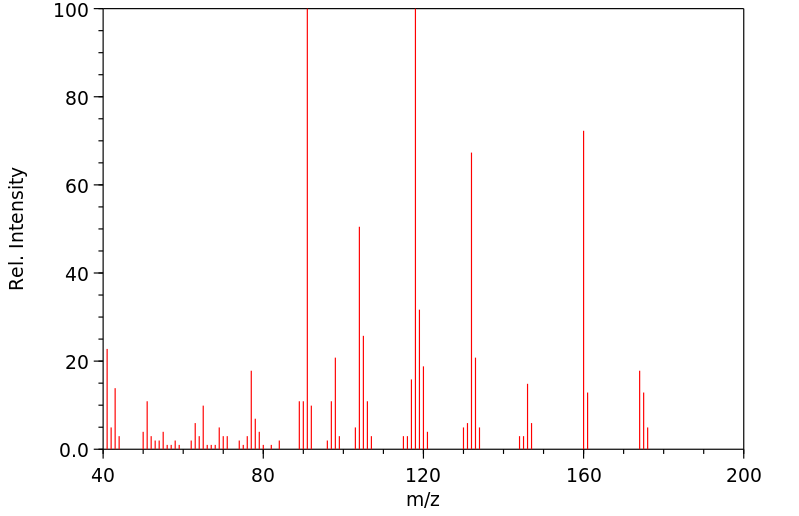N-戊基-1-苯基-甲亚胺 | 22710-00-5
中文名称
N-戊基-1-苯基-甲亚胺
中文别名
——
英文名称
N-pentyl-1-phenylmethanimine
英文别名
1-Pentanamine, N-(phenylmethylene)-
CAS
22710-00-5
化学式
C12H17N
mdl
——
分子量
175.274
InChiKey
NNTVKFAXDYRERB-UHFFFAOYSA-N
BEILSTEIN
——
EINECS
——
-
物化性质
-
计算性质
-
ADMET
-
安全信息
-
SDS
-
制备方法与用途
-
上下游信息
-
文献信息
-
表征谱图
-
同类化合物
-
相关功能分类
-
相关结构分类
物化性质
-
保留指数:1429
计算性质
-
辛醇/水分配系数(LogP):3.3
-
重原子数:13
-
可旋转键数:5
-
环数:1.0
-
sp3杂化的碳原子比例:0.42
-
拓扑面积:12.4
-
氢给体数:0
-
氢受体数:1
安全信息
-
海关编码:2925290090
SDS
反应信息
-
作为反应物:描述:参考文献:名称:Gangadasu; Narender; China Raju, Indian Journal of Chemistry - Section B Organic and Medicinal Chemistry, 2005, vol. 44, # 12, p. 2598 - 2600摘要:DOI:
-
作为产物:描述:N-benzyl-N-(butylidene)amine 在 potassium tert-butylate 作用下, 反应 1.0h, 以93%的产率得到N-戊基-1-苯基-甲亚胺参考文献:名称:Gangadasu; Narender; China Raju, Indian Journal of Chemistry - Section B Organic and Medicinal Chemistry, 2005, vol. 44, # 12, p. 2598 - 2600摘要:DOI:
文献信息
-
Efficient nickel-catalysed<i>N</i>-alkylation of amines with alcohols作者:Anastasiia Afanasenko、Saravanakumar Elangovan、Marc C. A. Stuart、Giuseppe Bonura、Francesco Frusteri、Katalin BartaDOI:10.1039/c8cy01200h日期:——selective N-alkylation of amines with alcohols, that is in situ generated from Ni(COD)2 and KOH under ligand-free conditions. This novel method is very efficient for the functionalization of aniline and derivatives with a wide range of aromatic and aliphatic alcohols as well as diols and exhibits excellent functional group tolerance including halides, benzodioxane and heteroaromatic groups. Several TEM measurements通过借用氢策略使胺与醇选择性地进行N烷基化反应是一种突出的可持续催化方法,该方法产生水作为唯一的副产物,非常适合可广泛衍生自可再生能源的醇反应伙伴的催化转化资源。集中研究致力于开发主要基于昂贵的贵金属的新型催化剂。但是,用于这种转化的均相或非均相非贵金属催化剂的可用性非常有限。本文中,我们提出了一种高活性且非常易于制备的镍基催化剂体系,用于将胺与醇选择性地进行N-烷基化,该反应是就地进行的。在无配体条件下由Ni(COD)2和KOH生成。这种新方法对于苯胺及其衍生物与各种芳香族和脂肪族醇以及二醇的官能化非常有效,并且具有出色的官能团耐受性,包括卤化物,苯并二恶烷和杂芳族基团。为了结合活性催化剂的性质和影响反应活性的因素,进行了几种TEM测量和元素分析的结合。
-
Transient Imine as a Directing Group for the Metal-Free <i>o</i>-C–H Borylation of Benzaldehydes作者:Supriya Rej、Naoto ChataniDOI:10.1021/jacs.0c13013日期:2021.2.24simple metal-free approach, utilizing an imine transient directing group. The strategy covers a wide spectrum of reactions and (i) even highly sterically hindered C–H bonds can be borylated smoothly, (ii) despite the presence of other potential directing groups, the reaction selectively occurs at the o-C–H bond of the benzaldehyde moiety, and (iii) natural products appended to benzaldehyde derivatives canOrganoboron试剂是重要的合成中间体,在合成有机化学中具有广泛的应用。当前使用的选择性硼化策略很大程度上依赖于过渡金属催化剂的使用。因此,非常需要确定更温和的无过渡金属硼化条件。我们在本文中提出了一种统一的策略,该方法使用一种简单的无金属方法,利用一个亚胺瞬态导向基团,对缺电子的苯甲醛衍生物进行选择性C–H硼化。该策略涵盖了广泛的反应,并且(i)即使是高度空间位阻的C–H键也可以顺利地被硼化,(ii)尽管存在其他潜在的导向基团,但该反应还是选择性地在o处发生。苯甲醛部分的-C–H键,以及(iii)附加到苯甲醛衍生物上的天然产物也可以产生适当的硼化产物。此外,该方案的有效性通过以下事实得以证实:即使在一系列外部杂质的存在下,反应也会进行。
-
<scp> Fe <sub>2</sub> Mn </scp> ( <scp> <i>μ</i> <sub>3</sub> ‐O </scp> )( <scp>COO</scp> ) <sub>6</sub> Cluster Based Stable <scp>MOF</scp> for Oxidative Coupling of Amines via Heterometallic Synergy作者:Ying‐Xia Wang、Hui‐Min Wang、Pan Meng、Dong‐Xia Song、Zhikai Qi、Xian‐Ming ZhangDOI:10.1002/cjoc.202100361日期:2021.11The direct catalytic oxidative coupling of amines is one of the attracting methods for the synthesis of a variety of pharmaceutical or industrial needed imines. Numerous earth-abundant manganese based salts, oxides, and complexes have been applied in this reaction. However, these compounds suffered from difficult separation, large catalyst loading, complicated reactivation or indeterminate activity胺的直接催化氧化偶联是合成各种医药或工业所需亚胺的吸引方法之一。许多地球上含量丰富的锰基盐、氧化物和络合物已用于该反应。然而,这些化合物存在分离困难、催化剂负载量大、再活化复杂或活性不确定等问题。考虑到具有晶体结构、精确组成和巨大表面积的金属有机骨架 (MOF) 在多相催化反应中具有优越的性能,在此,我们将 Mn 引入 [Fe 3 ( μ 3 -O)(CH 3 COO) 6 ],制备稳定 MOF 的前体之一,并得到 [Fe2 Mn( μ 3 -O)(CH 3 COO) 6 ]簇。用联苯-3,4',5-三羧酸 (BPTC) 替换配体后,基于异金属簇的 [Fe 2 Mn( μ 3 -O)(BPTC) 2 (DMF) 2 (H 2O)] (1) 得到。正如预期的那样,1 是稳定的,并且能够在室温下以 0.9 MOl% 的催化剂负载量有效和选择性地催化胺的均偶联或交叉偶联。对照实验表明,1 的催化活性主要来自
-
Redox-Neutral Imination of Alcohol with Azide: A Sustainable Alternative to the Staudinger/Aza-Wittig Reaction作者:Huaifeng Li、Daniel Lupp、Pradip K. Das、Li Yang、Théo P. Gonçalves、Mei-Hui Huang、Marwa El Hajoui、Lan-Chang Liang、Kuo-Wei HuangDOI:10.1021/acscatal.1c00379日期:2021.4.2The traditional Staudinger/aza-Wittig reaction represents one of the most powerful tools for imine formation. However, for this multistep procedure, the sacrificial phosphine has to be used, resulting in difficulties in the purification process and waste disposal at the same time. Here, we report a redox-neutral azide–alcohol imination methodology enabled by a base-metal nickel PN3 pincer catalyst
-
一种萘并恶唑类膦氧化合物及其合成方法和 作为配体的催化应用
表征谱图
-
氢谱1HNMR
-
质谱MS
-
碳谱13CNMR
-
红外IR
-
拉曼Raman
-
峰位数据
-
峰位匹配
-
表征信息
同类化合物
(βS)-β-氨基-4-(4-羟基苯氧基)-3,5-二碘苯甲丙醇
(S,S)-邻甲苯基-DIPAMP
(S)-(-)-7'-〔4(S)-(苄基)恶唑-2-基]-7-二(3,5-二-叔丁基苯基)膦基-2,2',3,3'-四氢-1,1-螺二氢茚
(S)-盐酸沙丁胺醇
(S)-3-(叔丁基)-4-(2,6-二甲氧基苯基)-2,3-二氢苯并[d][1,3]氧磷杂环戊二烯
(S)-2,2'-双[双(3,5-三氟甲基苯基)膦基]-4,4',6,6'-四甲氧基联苯
(S)-1-[3,5-双(三氟甲基)苯基]-3-[1-(二甲基氨基)-3-甲基丁烷-2-基]硫脲
(R)富马酸托特罗定
(R)-(-)-盐酸尼古地平
(R)-(-)-4,12-双(二苯基膦基)[2.2]对环芳烷(1,5环辛二烯)铑(I)四氟硼酸盐
(R)-(+)-7-双(3,5-二叔丁基苯基)膦基7''-[((6-甲基吡啶-2-基甲基)氨基]-2,2'',3,3''-四氢-1,1''-螺双茚满
(R)-(+)-7-双(3,5-二叔丁基苯基)膦基7''-[(4-叔丁基吡啶-2-基甲基)氨基]-2,2'',3,3''-四氢-1,1''-螺双茚满
(R)-(+)-7-双(3,5-二叔丁基苯基)膦基7''-[(3-甲基吡啶-2-基甲基)氨基]-2,2'',3,3''-四氢-1,1''-螺双茚满
(R)-(+)-4,7-双(3,5-二-叔丁基苯基)膦基-7“-[(吡啶-2-基甲基)氨基]-2,2”,3,3'-四氢1,1'-螺二茚满
(R)-3-(叔丁基)-4-(2,6-二苯氧基苯基)-2,3-二氢苯并[d][1,3]氧杂磷杂环戊烯
(R)-2-[((二苯基膦基)甲基]吡咯烷
(R)-1-[3,5-双(三氟甲基)苯基]-3-[1-(二甲基氨基)-3-甲基丁烷-2-基]硫脲
(N-(4-甲氧基苯基)-N-甲基-3-(1-哌啶基)丙-2-烯酰胺)
(5-溴-2-羟基苯基)-4-氯苯甲酮
(5-溴-2-氯苯基)(4-羟基苯基)甲酮
(5-氧代-3-苯基-2,5-二氢-1,2,3,4-oxatriazol-3-鎓)
(4S,5R)-4-甲基-5-苯基-1,2,3-氧代噻唑烷-2,2-二氧化物-3-羧酸叔丁酯
(4S,4''S)-2,2''-亚环戊基双[4,5-二氢-4-(苯甲基)恶唑]
(4-溴苯基)-[2-氟-4-[6-[甲基(丙-2-烯基)氨基]己氧基]苯基]甲酮
(4-丁氧基苯甲基)三苯基溴化磷
(3aR,8aR)-(-)-4,4,8,8-四(3,5-二甲基苯基)四氢-2,2-二甲基-6-苯基-1,3-二氧戊环[4,5-e]二恶唑磷
(3aR,6aS)-5-氧代六氢环戊基[c]吡咯-2(1H)-羧酸酯
(2Z)-3-[[(4-氯苯基)氨基]-2-氰基丙烯酸乙酯
(2S,3S,5S)-5-(叔丁氧基甲酰氨基)-2-(N-5-噻唑基-甲氧羰基)氨基-1,6-二苯基-3-羟基己烷
(2S,2''S,3S,3''S)-3,3''-二叔丁基-4,4''-双(2,6-二甲氧基苯基)-2,2'',3,3''-四氢-2,2''-联苯并[d][1,3]氧杂磷杂戊环
(2S)-(-)-2-{[[[[3,5-双(氟代甲基)苯基]氨基]硫代甲基]氨基}-N-(二苯基甲基)-N,3,3-三甲基丁酰胺
(2S)-2-[[[[[((1S,2S)-2-氨基环己基]氨基]硫代甲基]氨基]-N-(二苯甲基)-N,3,3-三甲基丁酰胺
(2S)-2-[[[[[[((1R,2R)-2-氨基环己基]氨基]硫代甲基]氨基]-N-(二苯甲基)-N,3,3-三甲基丁酰胺
(2-硝基苯基)磷酸三酰胺
(2,6-二氯苯基)乙酰氯
(2,3-二甲氧基-5-甲基苯基)硼酸
(1S,2S,3S,5S)-5-叠氮基-3-(苯基甲氧基)-2-[(苯基甲氧基)甲基]环戊醇
(1S,2S,3R,5R)-2-(苄氧基)甲基-6-氧杂双环[3.1.0]己-3-醇
(1-(4-氟苯基)环丙基)甲胺盐酸盐
(1-(3-溴苯基)环丁基)甲胺盐酸盐
(1-(2-氯苯基)环丁基)甲胺盐酸盐
(1-(2-氟苯基)环丙基)甲胺盐酸盐
(1-(2,6-二氟苯基)环丙基)甲胺盐酸盐
(-)-去甲基西布曲明
龙蒿油
龙胆酸钠
龙胆酸叔丁酯
龙胆酸
龙胆紫-d6
龙胆紫







